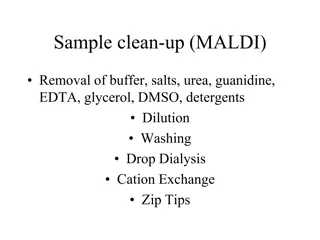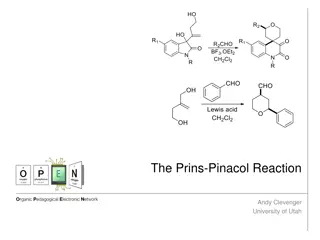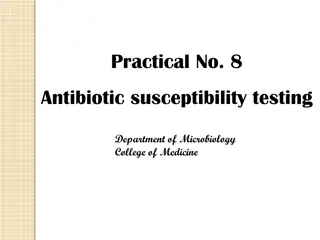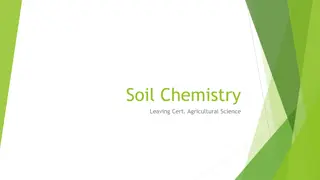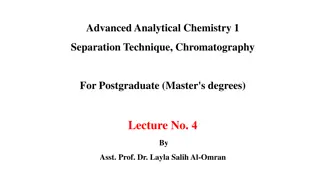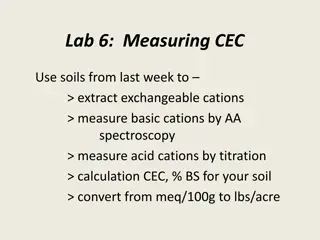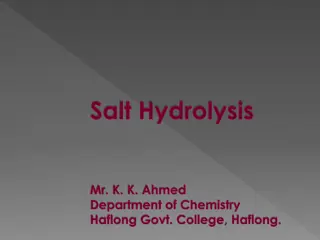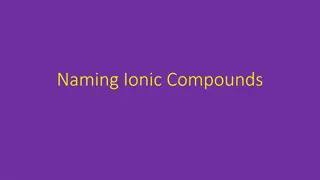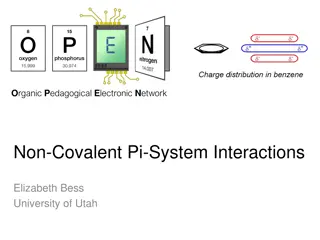Protein Sample Clean-Up Methods for MALDI Analysis
Protein sample clean-up for MALDI involves removing various contaminants like buffer, salts, urea, guanidine, EDTA, glycerol, DMSO, and detergents through methods such as dilution, washing, drop dialysis, cation exchange, and solid phase extraction using Zip tips. The process aims to reduce interfer
0 views • 8 slides
Chemistry Concepts: Valence Electrons, Ion Charges, and Ionic Compounds
Explore various key concepts in chemistry such as valence electrons in magnesium, Lewis Dot structure for silicon, charges on ions like strontium, formation of ions to achieve noble-gas electron configuration, elements forming ions with specific charges, and the octet rule. Learn about the character
1 views • 48 slides
Analysis of 1st Group of Cations: Ag+ and Pb2+ Ions
The analysis of cations in the 1st group involving Ag+ and Pb2+ ions is carried out by precipitating insoluble chloride salts in the presence of diluted HCl solution. The solubility products of AgCl, PbCl2, and Hg2Cl2 play a crucial role in the precipitation reactions. Various reagents such as HCl,
0 views • 7 slides
Understanding Complex Ions and Coordinate Bonds in Chemistry
Complex ions in chemistry are formed when transition metals or their ions bond with ligands through coordinate bonds. Ligands utilize their lone pairs of electrons to form dative covalent bonds with transition metals, determining the coordination number of the cation. Complex ions play a crucial rol
1 views • 29 slides
Understanding the Prins-Pinacol Reaction in Organic Chemistry
The Prins-Pinacol reaction involves a two-step process starting with the Prins reaction and followed by the Pinacol rearrangement. This reaction, discovered in 1919 by Hendrick J. Prins, is a crucial transformation in organic chemistry, leading to the formation of important carbonyl compounds. The m
0 views • 14 slides
Understanding Antibiotic Susceptibility Testing
Antibiotic susceptibility testing is crucial in determining the effectiveness of antibiotics against specific bacteria. The Kirby-Bauer method, a standardized paper disk agar diffusion method, is commonly used for this purpose. By observing zones of inhibition around antibiotic disks on agar plates,
1 views • 21 slides
Understanding Soil Chemistry in Agricultural Science
Explore the role of soil colloids and cations in agricultural science, how opposites attract to form floccules, and the impact of cation exchange on soil fertility through liming. Gain insights into the processes that influence soil nutrient availability and plant growth.
0 views • 8 slides
Understanding Ion Exchange Chromatography in Analytical Chemistry
Ion exchange chromatography is a powerful separation technique that isolates ions and charged molecules based on their affinity for a charged matrix. This method involves interactions between the analyte and matrix influenced by factors like net charge, ionic strength, and pH. Through cation exchang
2 views • 18 slides
Comprehensive Soil Cation Exchange Capacity (CEC) Measurement Lab Procedure
This lab exercise focuses on measuring CEC using soil samples, extracting exchangeable cations, analyzing basic cations through AA spectroscopy, titrating acid cations, calculating CEC and base saturation percentage for the soil, and converting cation measurements from meq/100g to lbs/acre. The step
0 views • 9 slides
Important Facts About Nicotine: Usage, Properties, and Sources
Nicotine is a stimulant and parasympathomimetic alkaloid naturally produced in nightshade family plants. It is used in smoking cessation. Nicotine is a hygroscopic liquid, soluble in various substances, and undergoes conversion processes under specific conditions. It has two enantiomeric forms and i
0 views • 15 slides
Understanding Salt Hydrolysis in Chemistry
Salt hydrolysis is a chemical process in which a salt reacts with water to produce an acid and a base. This reaction occurs when the cation or anion of the salt interacts with water, resulting in either an acidic or basic solution. The type of hydrolysis depends on the strength of the acid and base
0 views • 6 slides
Understanding Naming Ionic Compounds and Formulas
Ions and salts play a crucial role in forming solid compounds known as salts. By following specific rules, you can name ionic compounds based on the cation and anion present. Determining formulas involves identifying charges and balancing them. Explore the process through examples like KCl, MgO, AlC
0 views • 11 slides
Understanding Non-Covalent Pi-System Interactions in Molecular Structures
Non-covalent interactions play a crucial role in chemical selectivity and molecular recognition. This article discusses the significance of Pi-system interactions, including Pi-Pi and Cation-Pi interactions, in stabilizing molecular structures like DNA helices and G-quadruplexes. Insights into molec
0 views • 6 slides
